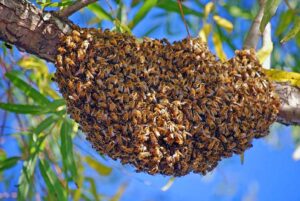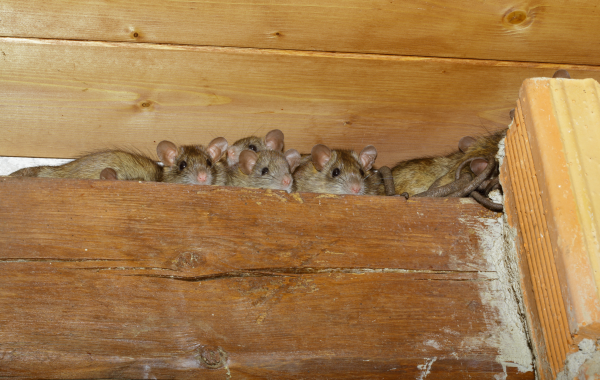
What Is A Swarm Of Honey Bees?
Swarming is the process by which honey bee colonies reproduce to form new colonies. When a honey bee colony outgrows its home, becomes too congested, or too populated for the queen’s pheromones to control the entire workforce, then the workers signal that it is time to swarm. The workers begin building swarm cells for new queens. Once the swarm cells are constructed, and the queen lays eggs in them, then the colony changes its behavior. Foraging slows down, and the workers begin erratic movements within the hive. Meanwhile, the queen quits laying eggs and reduces her weight to be able to fly. When the queen is ready, she leaves the hive and is followed by about half of the workers in a massive cloud of flying bees. The queen is not as strong of a flyer as the worker bees, and will find a nearby tree, fence, or even your car, to land on and rest. She will emit pheromones that signal the workers to cluster around her while she rests. The cluster will remain there for several hours while scout bees explore the area for a new home. Often the cluster will leave, travel a mile or more, and reform on another branch far away from the original hive. The cluster will remain until scout bees locate a new hive or cavity to occupy. Once a suitable home is found, the entire cluster will take flight and move to the new location where it will begin building comb, developing new brood, and gathering pollen and nectar.
When Do Swarms Occur?
Usually, swarming activity coincides with the nectar flow in the spring. This is when a wide variety of plants are in bloom, making nectar and pollen resources bountiful. The primary swarm season is between March and May, but occasionally secondary swarms occur later in the season. These secondary swarms often are not as successful in establishing new colonies because they are unable to build new combs and collect sufficient resources in time to survive the coming winter.
Are Swarms Dangerous?
When honey bees are swarming, they are more docile and not nearly as defensive as they are around their hive because they are not protecting brood (developing young bees) or honey stores. They are more concerned with scouting for a new home and staying in protective clusters around the queen. If disturbed or agitated, they will defend the cluster; therefore, it is advisable for people to keep their distance from a swarm of bees to avoid being stung.
The Swarm Has Been There All Day. How Long Will It Take For Them To Leave?
This is difficult to answer because it depends on weather conditions and when the scout bees find a suitable cavity to colonize. Typically, swarms only stay in one place for a few hours or maybe a day, but some swarms may remain for several days. Although the swarm may be alarming, especially to people who are allergic to bee stings, please do not spray the swarm with an insecticide or attempt to destroy it. This actually may agitate the bees and increase the likelihood of being stung. More importantly, honey bees face many perils and have suffered significant declines in recent years; therefore, bee swarms should be protected rather than destroyed. Many beekeepers are eager to collect swarms to start new colonies, enhancing the chances that the swarm will survive. The best way to find a swarm collector is to contact a local beekeeping association in your area.


